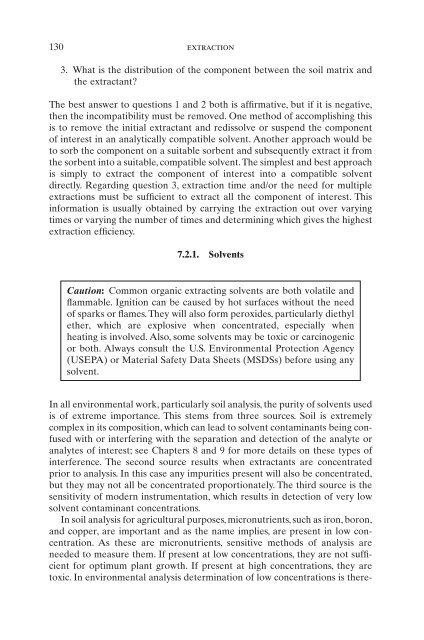Introduction to Soil Chemistry
Introduction to Soil Chemistry
Introduction to Soil Chemistry
You also want an ePaper? Increase the reach of your titles
YUMPU automatically turns print PDFs into web optimized ePapers that Google loves.
130 extraction<br />
3. What is the distribution of the component between the soil matrix and<br />
the extractant?<br />
The best answer <strong>to</strong> questions 1 and 2 both is affirmative, but if it is negative,<br />
then the incompatibility must be removed. One method of accomplishing this<br />
is <strong>to</strong> remove the initial extractant and redissolve or suspend the component<br />
of interest in an analytically compatible solvent. Another approach would be<br />
<strong>to</strong> sorb the component on a suitable sorbent and subsequently extract it from<br />
the sorbent in<strong>to</strong> a suitable, compatible solvent.The simplest and best approach<br />
is simply <strong>to</strong> extract the component of interest in<strong>to</strong> a compatible solvent<br />
directly. Regarding question 3, extraction time and/or the need for multiple<br />
extractions must be sufficient <strong>to</strong> extract all the component of interest. This<br />
information is usually obtained by carrying the extraction out over varying<br />
times or varying the number of times and determining which gives the highest<br />
extraction efficiency.<br />
7.2.1. Solvents<br />
Caution: Common organic extracting solvents are both volatile and<br />
flammable. Ignition can be caused by hot surfaces without the need<br />
of sparks or flames. They will also form peroxides, particularly diethyl<br />
ether, which are explosive when concentrated, especially when<br />
heating is involved. Also, some solvents may be <strong>to</strong>xic or carcinogenic<br />
or both. Always consult the U.S. Environmental Protection Agency<br />
(USEPA) or Material Safety Data Sheets (MSDSs) before using any<br />
solvent.<br />
In all environmental work, particularly soil analysis, the purity of solvents used<br />
is of extreme importance. This stems from three sources. <strong>Soil</strong> is extremely<br />
complex in its composition, which can lead <strong>to</strong> solvent contaminants being confused<br />
with or interfering with the separation and detection of the analyte or<br />
analytes of interest; see Chapters 8 and 9 for more details on these types of<br />
interference. The second source results when extractants are concentrated<br />
prior <strong>to</strong> analysis. In this case any impurities present will also be concentrated,<br />
but they may not all be concentrated proportionately. The third source is the<br />
sensitivity of modern instrumentation, which results in detection of very low<br />
solvent contaminant concentrations.<br />
In soil analysis for agricultural purposes, micronutrients, such as iron, boron,<br />
and copper, are important and as the name implies, are present in low concentration.<br />
As these are micronutrients, sensitive methods of analysis are<br />
needed <strong>to</strong> measure them. If present at low concentrations, they are not sufficient<br />
for optimum plant growth. If present at high concentrations, they are<br />
<strong>to</strong>xic. In environmental analysis determination of low concentrations is there-
















